Tomato gardeners often get worried when they see Yellow Tomato Leaves. Tomato plants are highly valued for their juicy and flavorful fruits, but the health of their leaves is equally important for optimal growth and yield. The yellow tomato leaves indicates that there are underlying some issues which affecting the plant’s overall health.
However, it’s not always alarming as yellow tomato leaves is very common problem and almost every tomato gardener come across this problem at some time over the growing period.
In this article, we will explore the various reasons behind yellowing tomato leaves and provide practical solutions to address these problems effectively.
Reasons Behind Yellowing Tomato Leaves
There could be multiple reasons of yellowing tomato leaves. Most common problems have been listed below:
Nutritional Deficiencies
Nitrogen Deficiency
- Nitrogen is a vital element which helps in proper growth of leaf and stem. Insufficient nitrogen can lead to yellowing of the lower leaves, starting from the tips.
- To rectify this deficiency, consider using nitrogen-rich fertilizers or organic amendments like blood meal or fish emulsion.
Iron Deficiency
- When a plant doesn’t have enough iron, you might notice its leaves turning yellow between the veins, which is sometimes called “interveinal chlorosis. This occurs due to the inability of the plant to transport iron effectively.
- To combat iron deficiency, incorporate iron chelates or iron sulfate into the soil, ensuring optimal iron availability to the plants.
Phosphorus deficiency
- Phosphorus deficiency is characterized by a uniform yellowing of leaves.
- To fix this problem, you can use fertilizers that have more phosphorus in them, or you can put down bone meal, which is really good for adding phosphorus to the soil.
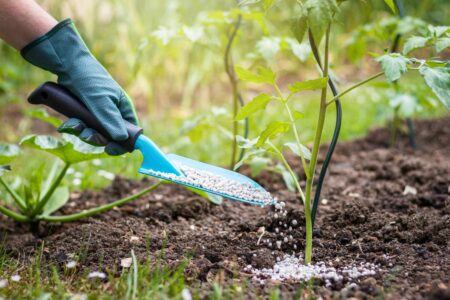
Water-related Issues Causing Yellowing Tomato Leaves
Overwatering
- Overwatering can result in yellowing of tomato leaves due to oxygen deprivation in the root zone.
- To prevent overwatering, ensure proper drainage and allow the soil to dry slightly between waterings.
Underwatering
- Insufficient watering can cause stress to tomato plants, leading to yellowing of leaves.
- To prevent underwatering, monitor soil moisture levels regularly and water deeply whenever the top inch of soil feels dry.
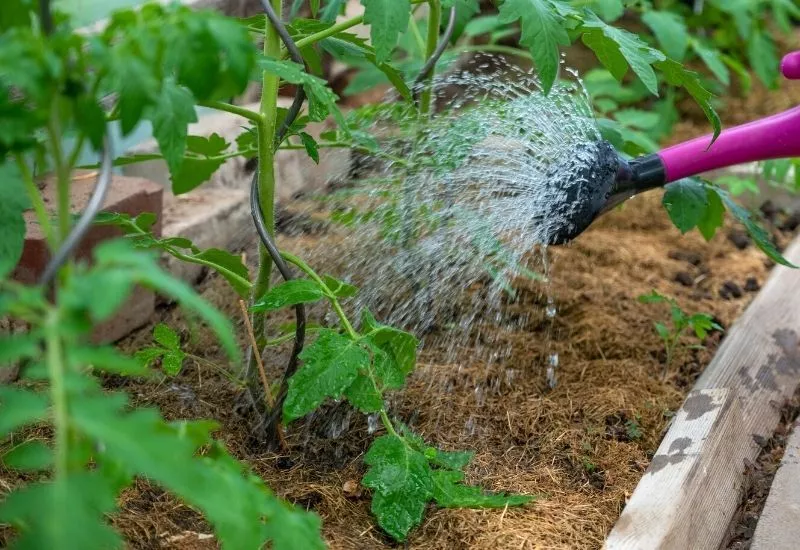
Environmental Factors causing Yellowing Tomato Leaves
Excessive Sunlight Exposure
- Leaving your plants out in strong sunlight for too long can give them a sunburn, which shows up as yellow patches on the leaves.
- Provide shade or use shade cloth to protect tomato plants from direct sunlight during the hottest hours of the day.
Extreme Temperatures
- Tomato plants are sensitive to extreme temperatures, and both high and low temperatures can cause leaf yellowing.
- Use protective covers during cold spells or provide temporary shade during heatwaves to create a more favorable growing environment.
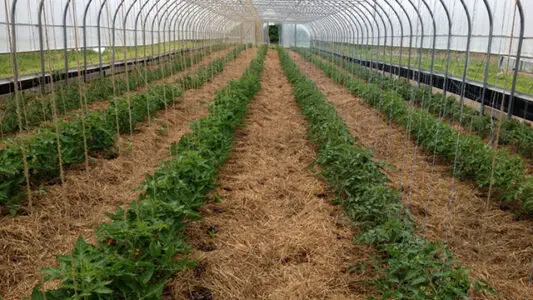
Wind Damage
- Strong winds can physically damage tomato plants, causing yellowing or browning of leaves.
- Implementing windbreaks or using stakes and cages to support the plants can help minimize wind damage.
Pest and Disease Infestation causing Yellow Tomato Leaves
Common Pests Affecting Tomato Plants
- Pests like aphids, whiteflies and spider mites can damage the leaves and leading to yellowing and distortion.
- Regular inspection and prompt pest management actions, such as using organic insecticidal soaps or introducing beneficial insects, can help control these pests effectively.
Common Diseases causing Yellowing Tomato Leaves
- Diseases like early blight, septoria leaf spot, and fusarium wilt can cause yellowing and wilting of tomato leaves.
- Employing proper sanitation practices, including removing infected plant debris and practicing crop rotation, are key in preventing and managing these diseases.
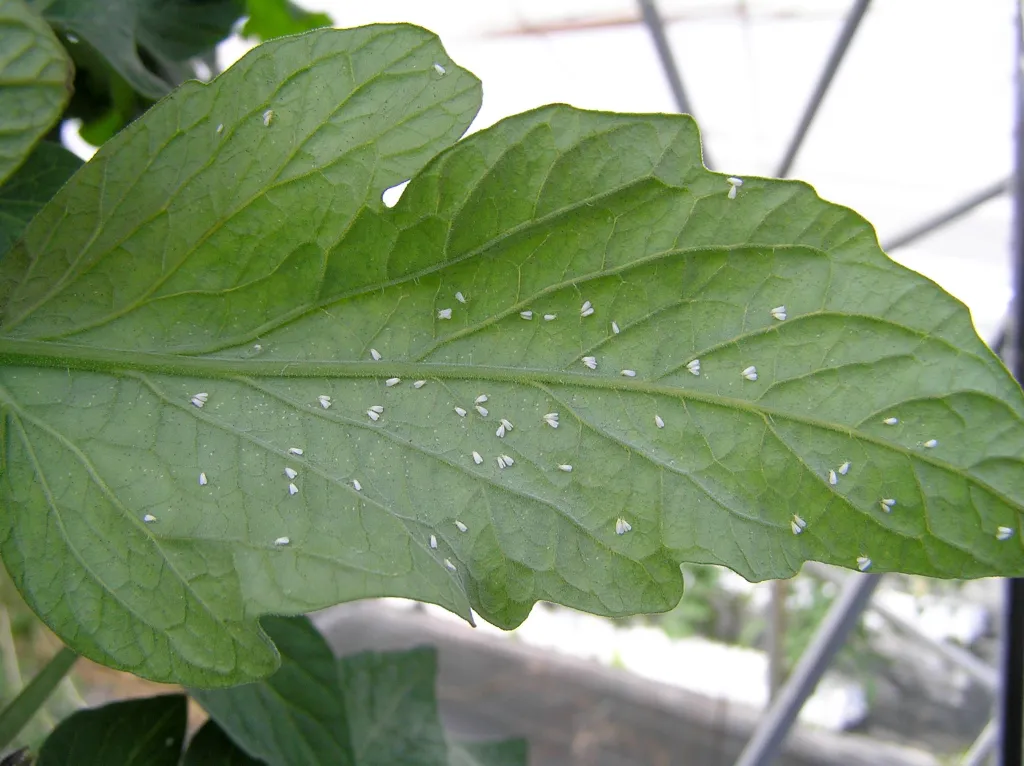
Identifying the Cause of Yellowing Tomato Leaves
Let’s go through some different ways to identify causes of yellowing Tomato Leaves.
Observing Leaf Patterns and Appearance
Uniform Yellowing Tomato Leaves
- When the yellowing occurs uniformly across all tomato leaves, it usually indicates a nutrient deficiency or over/underwatering issue.
- It is essential to closely examine other symptoms and conduct further tests to pinpoint the exact cause.
Yellowing from the Edges
- Yellowing that starts from leaf edges and progresses inward suggests a potential nutrient deficiency, such as nitrogen or magnesium.
Spots or Patterns on Tomato Leaves
- If yellowing is accompanied by spots or patterns on leaves, it may indicate a fungal or bacterial disease affecting the plant.
- Take note of the specific patterns, colors, and textures to assist in disease diagnosis.
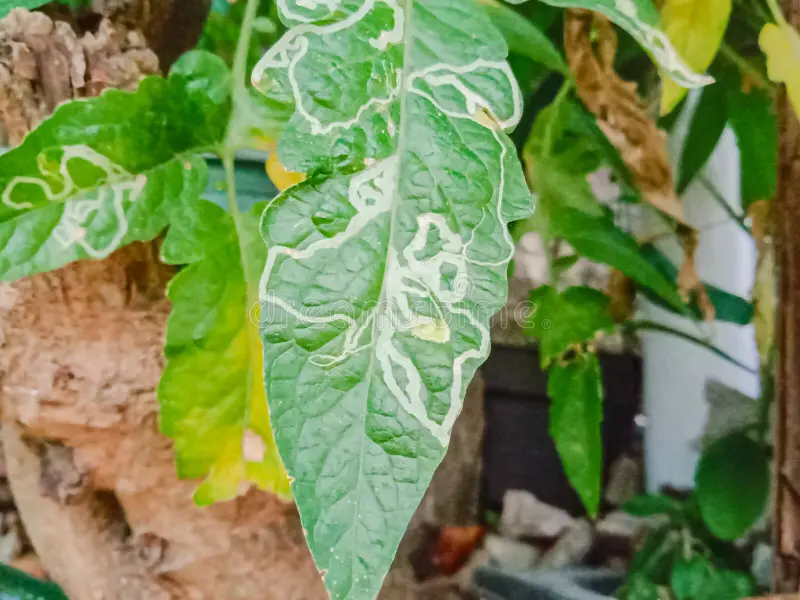
Conducting Soil and Water Tests
By conducting following soil and water tests, we can get an idea of the cause of yellowing tomato leaves.
Testing pH Levels
- A pH imbalance in the soil can affect nutrient availability for plants. Yellowing tomato leaves may be a result of pH extremes.
- Conduct a soil pH test using a DIY kit or seek professional testing services to determine the appropriate pH range for healthy tomato growth.
Checking Nutrient Levels
- Deficiencies or imbalances in essential nutrients can manifest as yellowing of tomato leaves. Conducting a soil test can help identify nutrient deficiencies.
- Consider sending a soil sample to a reputable laboratory for comprehensive nutrient analysis.
Assessing Water Quality
- Poor water quality, high in salts or contaminants, can contribute to tomato leaf yellowing.
- Test the water source for pH, salinity, and nutrient levels, if necessary, to ensure it is suitable for tomato irrigation.
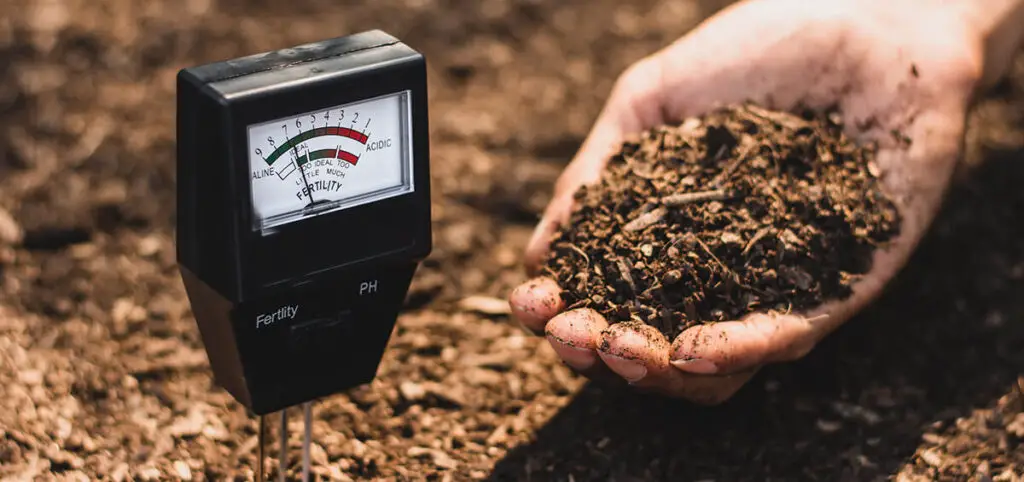
Solutions for Yellow Tomato Leaves
Here are we proposing some solutions which are being experimented over the times to get better tomato plants.
Nutritional Adjustments
Fertilizer Selection and Application Methods
- Choose a fertilizer formula tailored for tomatoes and follow the recommended application rates to address nutrient deficiencies.
- Consider using slow-release or organic fertilizers to provide a more sustained nutrient supply.
Soil Amendments and Supplements
- To make your soil better for tomato growing, you can mix in things like compost or really well-aged manure.
- Incorporate specific micronutrient supplements like foliar sprays or granular amendments to overcome nutrient deficiencies.
Identifying Nutrient Deficiencies through Leaf Analysis
- Conduct leaf analysis to determine nutrient imbalances accurately.
- Collect leaf samples and send them to a specialized laboratory for a comprehensive analysis.
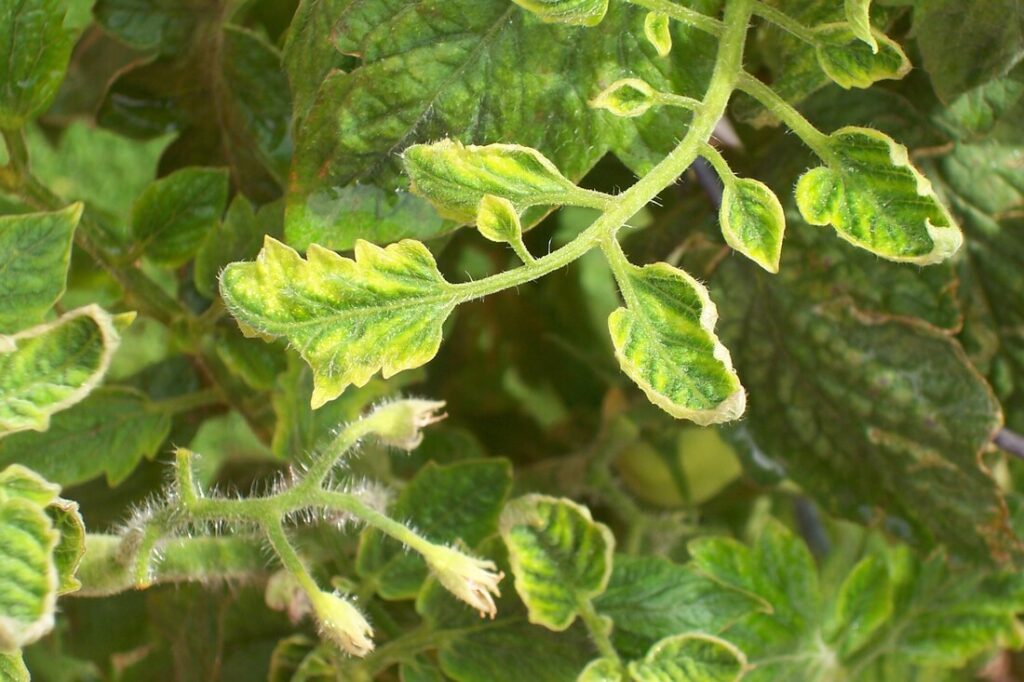
Proper Watering Techniques
Determining Watering Frequency
- Create a watering plan that takes into account what the plant needs, the weather around it and how damp the soil is.
- Water deeply and infrequently to encourage deep root growth and reduce water stress.
Techniques for Watering Tomato Plants Effectively
- Opt for drip irrigation or soaker hoses to deliver water directly to the roots and minimize leaf wetting.
- Water early in the morning to allow leaves to dry quickly and reduce the risk of fungal diseases.
Mulching for Moisture Conservation
- Apply a layer of organic mulch, such as straw or wood chips, around tomato plants to conserve soil moisture.
- Mulching also helps regulate soil temperature and suppress weed growth.
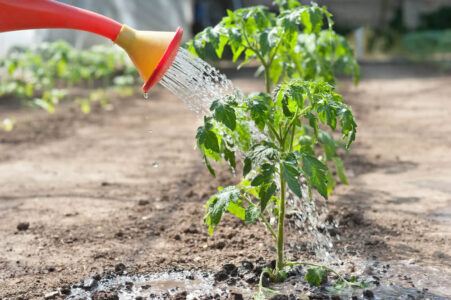
Managing Environmental Factors
Providing Shade or Filtered Sunlight
- Shield tomato plants from excessive sunlight by using shade cloths or planting them in areas with partial shade.
- Gradually acclimate plants to full sunlight to minimize leaf stress.
Protecting from Extreme Temperatures
- During cold snaps, cover tomato plants with frost blankets or cloches to shield them from freezing temperatures.
- Use shade cloth or erect temporary shelters to provide relief from scorching heat.
Implementing Windbreaks
- Plant windbreaks, such as tall shrubs or temporary barriers, to shield tomato plants from strong winds.
- Positioning support structures, like stakes or cages, can also provide stability against wind damage.
Pest and Disease Control
Recognizing and Preventing Common Tomato Pests
- Regularly inspect plants for signs of pest infestation and promptly intervene with appropriate organic pest control methods.
- Create a diverse garden ecosystem to attract beneficial insects that naturally control pest populations.
Effective ways to Combat Tomato Diseases
- Practice good sanitation by removing and disposing of infected plant debris.
- Apply appropriate organic fungicides or bactericides, following label instructions, to combat fungal or bacterial diseases.
Organic Pest and Disease Management Options
- Explore natural pest control methods, such as using neem oil, insecticidal soaps, or introducing predatory insects to control pests.
- Choose disease-resistant tomato varieties to minimize disease susceptibility.
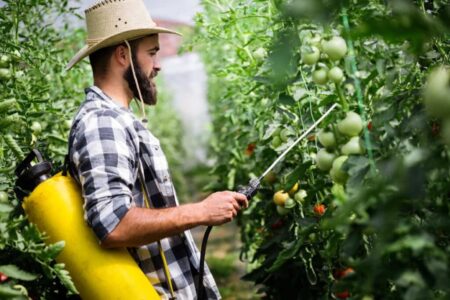
Prevention and Maintenance Tips
Here are some tips to prevent tomato leaves to be yellow.
Regular Plant Inspection and Care
Consistent Monitoring of Tomato Plant Health
- Regularly inspect tomato plants for any signs of stress, pest infestation, or disease symptoms.
- Early detection can help prevent further damage and facilitate timely interventions.
Timely Removal of Affected Tomato Leaves
- Trim and remove yellowing or diseased leaves promptly to prevent the spread of pathogens.
- Dispose of removed leaves away from the growing area to minimize disease transmission.
Proper Pruning Techniques
- Employ correct pruning practices to maintain adequate airflow and optimize light penetration within the plant canopy.
- Prune selectively to remove overcrowded and diseased branches, promoting healthy growth.
Implementing Crop Rotation
Crop rotation helps break pest and disease cycles by disrupting their life cycles and reducing their population. It also improves soil health by minimizing nutrient depletion and suppressing soilborne pathogens.
Planning Crop Rotation to Prevent Tomato Plant Diseases
- Rotate tomatoes with non-related crops, such as legumes or greens, to minimize the risk of disease recurrence.
- Avoid replanting tomatoes or other related crops in the same location for several years.
Compatible Plant Choices for Rotation
- Opt for crops that replenish soil nutrients, deter pests, or break up compacted soil when planning crop rotation.
- Examples include beans, peas, lettuce, or cover crops like clover or rye.
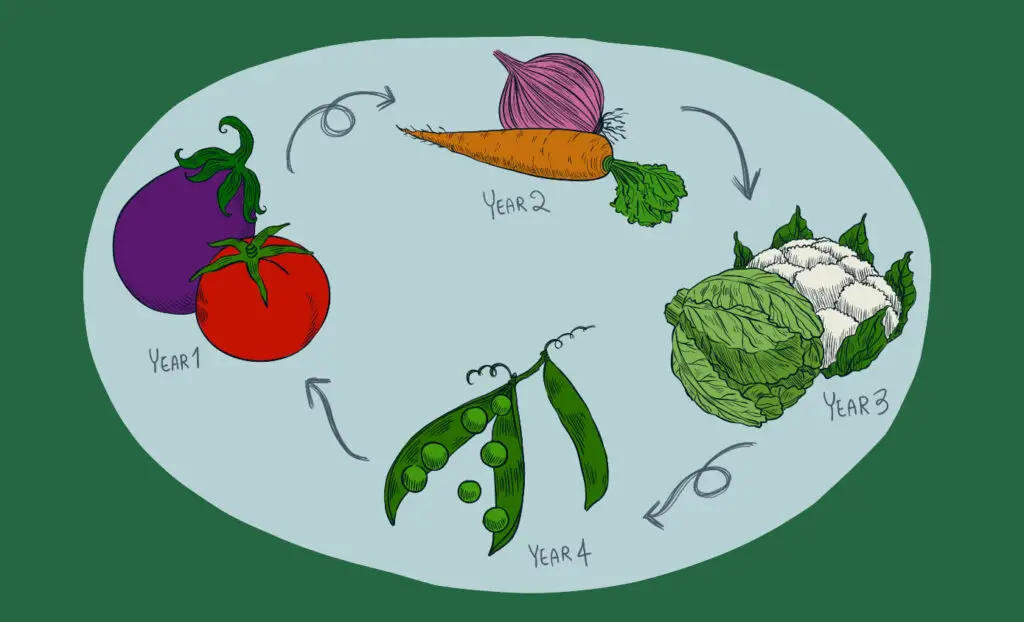
Preemptive Soil and Leaf Testing
Conduct regular soil testing to monitor nutrient levels, pH, and other soil properties that impact plant health. This enables timely adjustments and nutrient management for optimal tomato growth.
Professional Testing Services and DIY kits
- Consult professional soil testing services or use DIY soil testing kits, following their instructions carefully.
- These professional or DIY tests provide detailed analysis, ensuring accuracy and informed decision-making.
Incorporating Regular Tomato Leaf Analysis
- Periodically analyze tomato leaves for nutrient deficiencies or imbalances, especially if yellowing persists.
- By doing leaf analysis, can get valuable insights of plant health and can guide targeted nutrient supplementation.
Summary
To sum it up, tomato leaves turning yellow can happen for different reasons, like not getting enough nutrients, problems with water, the environment it’s in, or bugs and diseases affecting it
You can make the tomato leaves better by changing what they eat, watering them right, taking care of where they’re growing and using things to keep pests and diseases away.
To keep your tomato plants healthy and make sure they make lots of fruits, it’s good to regularly check them, change where you plant them, and test things before problems even show up.
Frequently Asked Questions (FAQs)
Can yellow tomato leaves be saved, or should they be removed?
In some cases, yellow tomato leaves can recover if the underlying issue is addressed promptly. However, if the leaves are severely damaged or show signs of disease, it is often best to remove them to prevent further spread and promote overall plant health.
How often should watering be done for tomato plants?
The frequency of watering depends on various factors such as soil type, weather conditions, and stage of plant growth. As a general guideline, tomato plants typically require deep watering every 3-5 days, adjusting based on soil moisture levels and weather conditions.
Are yellow leaves always an indicator of a nutrient deficiency?
When tomato leaves turn yellow, it might mean they need more nutrients, but it could also be because of overwatering, underwatering, environmental stress or having bugs and diseases bothering them. It is crucial to consider other symptoms and conduct tests to accurately identify the cause.
What are some natural pest control methods for tomato plants?
Natural pest control methods for tomato plants include introducing beneficial insects like ladybugs or lacewings, using insecticidal soaps or neem oil sprays, and practicing companion planting with pest-repellent herbs like basil or marigold.
When is the best time to conduct soil and leaf testing?
Soil testing can be conducted before planting or during the growing season to monitor changes in nutrient levels. Leaf testing is best done during the active growth period when the plant is actively photosynthesizing and accumulating nutrients. Consult testing guidelines or professionals for specific recommendations based on local conditions.

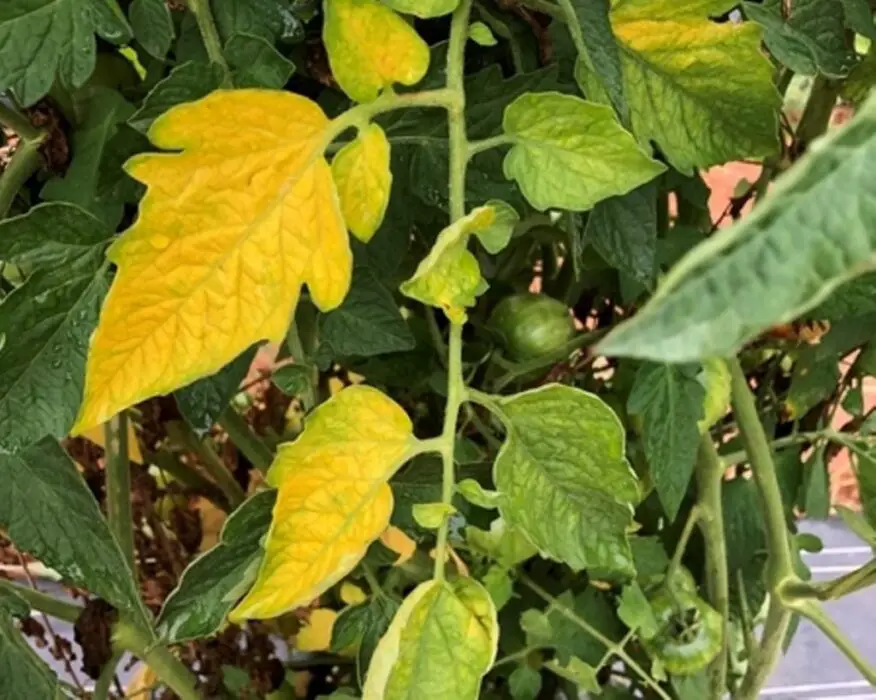
3 thoughts on “Yellow Tomato Leaves: Causes and Solutions”